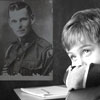Uncovering Past Lives ~ Part I
When past-life therapy is mentioned, many people reject the idea of looking into a past lifetime for problems. They claim to have enough troubles in the present. However, when they explore present issues and conflicts in therapy sessions, the problems nearly always result from painful events in earlier lifetimes.
In a therapy session we normally don’t direct clients into a past life, but guide them to locate the source of the problems or unwanted conditions in the present time. Their inner mind uncovers the time, place, and circumstances that caused the present-life situation. As we seek the source of current problems, people uncover emotionally painful moments and traumatic events in this or other lifetimes.
Clients seldom find luxury, fame, or wealth in other lifetimes. People claiming to have been past-life personalities such as Cleopatra, Julius Caesar, Napoleon, Anne Boleyn, or other notable persons are reported in the supermarket tabloids, but this does not occur in past-life therapy sessions.
In the Planning Stage in the Light, we plan the circumstances of life before we enter the physical state. The Lifescript is held in the inner mind, but we tend to forget it when we enter physical life. Past-life therapy is effective in accessing the subconscious, uncovering memories of traumatic experience, resolving the unfinished personal business of the past, all of which can lead to forgiveness. The result is healing the scars of the soul. A person can devote more of life’s energy to fulfilling the Lifescript.
Hypnosis is not necessary to uncover a past-life memory. Emotions and physical sensations one feels while relating the present life conflicts and the words or phrases used in expressing these feelings are used to guide a person to the source of the pain.
Emotions begin to intensify as the client describes a personal problem. Emotional turmoil is the doorway into the subconscious and the past-life memories or images associated with them. Affect is defined as feeling, emotion, or mood. The affect bridge or emotional link leads the client to an earlier, similar incident or traumatic event involving the same intense emotions.
“Soma” refers to the body. As the emotions intensify, heart and breathing rate accelerate, the client may feel a painful sensation somewhere in the body, perhaps the head, throat, chest, back, or belly. The somatic bridge involves physical sensations that connect the client to another incident involving the same physical sensation, usually in a prior lifetime, often a fatal wound. The pain is embedded in the soul consciousness as dangerous and life-threatening.
Metaphoric phrases such as: a pain in the neck; my aching back; I feel like I’m drowning; I feel paralyzed in my life; I can’t breathe; I just can’t seem to get moving; and other phrases may depict an actual event in the past. Repetition of the phrase will intensify the emotion, worsen the pain, and uncover the memory of the past-life traumatic event. This is the linguistic bridge.
The emotions, physical sensations, and descriptive phrases together form the bridge between now and then. These are the bridge inductions or links for uncovering past-life memories, and most people will recall past-life traumatic events when guided by a therapist trained in the techniques.
As the painful memory surfaces, the client may scream in fear, yell in anger, burst into sobs, retch, or become silent and still, as if hiding. They may clutch the chest as if suffering a heart attack, both hands may hold the head or the belly as the pain of a mortal wound wrenches cries from his contorted body.
This abreaction, that is, acting out through words and behavior, brings a catharsis (cleansing or purging) or release of repressed emotional energy associated with the original situation causing the conflict. This release also extends into the present life to relieve emotional tension and conflict. It seems to restore and refresh the spirit. This is the essence of healing.
Past-life therapy is based on a trauma model, that is, the client uncovers traumatic memories that cause problems and conflicts in the present life and acts out the past trauma. Abreaction and catharsis are integral to the process of past-life therapy.
Whether these are memories of actual or imagined events, metaphoric, symbolic, even archetypal images, the therapist works with the imagery and narrative and emotions as if they were real. They are real for the client, and the impact of these memories can seriously disrupt a person’s life.
As in dreams and the déjà vu experience, a client struggling with a problem is already entangled in the past event, perceiving it, feeling it, reacting to it as if it were now. The signs and symptoms of the client’s problems, both emotional and physical, are often reactions to the earlier trauma.
A past-life therapist assists the client in unraveling the misperceptions and misinterpretations, the false assumptions and judgments of past memories. The client is carefully guided to a clear understanding of the actual nature of the event, personal responsibility for the circumstances, the greater purpose served, and the spiritual learning inherent in the experience.
This experiential learning and understanding can bring immediate and permanent relief of present life conditions and problems. It seems people keep working on the same issue of past unfinished business until they get it right, even if it takes many lifetimes.
This is difficult for traditionally educated and trained therapists. The standard model of the mind stretches from birth to death. Many therapists still go along with Sigmund Freud, who contended the memories of a child before age five or six were irretrievable.
When a client in an altered state describes a scene from birth, pregnancy, or conception, a past-life memory, near-death or out-of-body experience, an abduction by aliens, or sexual abuse in cult rituals, there is often an immediate lack of acceptance by a traditional therapist, even denial that such a thing could be possible. This attitude of therapists eliminates the potential for emotional healing of the problem. The client is left with unresolved emotional pain and unrelenting physical manifestations.
Carolyn Myss, gifted medical clairvoyant and author, clearly describes the body/mind connection. Every thought travels through the biological system and activates a physiological response. Some are like depth charges, causing a reaction throughout the body. For example, fear causes an increase in heart rate, sweating, and tightness in the stomach. Loving thoughts can bring relaxation to the body. Some thoughts are unconscious, yet still cause reaction.
Traumatic memories and damaged bodies represent more than scars from events of the present life; they are the scars of the soul as well, not just the mind or body. These scars on the soul are carried into subsequent lifetimes, causing mental, emotional, and physical conditions. The conditions will persist until the past-life trauma is discovered, resolved, forgiven, and healed.
The subconscious mind retains memory of everything ever experienced by the being. This includes the present, prior, and potential future lifetimes, and the nonphysical realms between incarnations. Additionally, the entire track of awareness back to and including the experience of separating from Creator Source is embedded in the soul memory.
If there is anything in a present traumatic situation that is similar to anything in an earlier traumatic event, the mind will associate with the earlier trauma and the body will react in the present time. Expanding on the notion of mind/body connection, it is clear the soul memories must also be included; mind/body/soul is the holistic model of dis-ease and healing.
Past-Life Therapy for Phobia
A phobia is an unfounded fear, a strong aversion to something with no apparent cause. Such an inexplicable reaction can often be traced to death in prior lives. A phobia of water may be described as a fear of deep water, rushing water, or muddy water. It may be pounding waves on a shore, water over the knees, water higher than chest level, or water in the face. Often these specific details will accurately depict the conditions surrounding an earlier death.
Gene
The number one phobia among people is fear of public speaking. One client described his moment of terror as he stood before a crowd. All eyes turned toward him. It wasn’t the speech preparation, the size of the crowd, or even making a fool of himself. Simply, it was the feeling of their eyes on him.
In session, this feeling uncovered the memory of a lifetime when cowboys carried six-shooters. He had shot and killed a man and was summarily judged and sentenced to be hanged. As he mounted the scaffold, he did not feel fear. He had accepted the sentence. As a gunfighter, he had always known he would die of a bullet wound or by a rope around his neck. The noose was dropped over his head, and he looked out at the crowd of people who had gathered. Ghastly spectator sport; all the people were staring at him. The feeling of their eyes focused on him in that way was etched in his memory.
At that moment the trapdoor opened beneath his feet. He dropped to the end of the rope and died. The sea of eyes looking at him was his last memory and the source of the present fear. The last time everyone looked at him like that, he had died. Following our session, that fear ceased to bother him. This is a good example of how past-life trauma can affect the present, and how past-life therapy can uncover the cause and eliminate the problem.
Maureen
In a demonstration session during a training class, Maureen described her fear of snakes. A friend kept snakes in cages on his patio, and she could not go through the door onto his patio. She felt the fear as she talked about it. I used the affect bridge.
Dr. B.: “Recall a time recently when you felt that same fear of snakes.”
Her eyes opened wide and her gaze dropped to the floor. She wasn’t seeing the floor. This eye movement indicates the client is suddenly thrust into the emotional, and often visual, memory of the event.
C.: “Last week I started to watch a show on TV and there were snakes.”
Maureen pulled her feet up off the floor as if there were snakes in the room. She had instantly gone into an altered state, and her mind believed she was in immediate peril. The subconscious mind does not differentiate between reality and imagination, past or present time.
Dr. B.: “Let those feelings take you right back. Locate the source of the feelings.”
The answer came in a few seconds.
C.: “I’m outside a building and I’m real curious about what’s inside. I’m a man. I’m going through the door.”
It was dark inside this simple, church-like building. As his eyes grew accustomed to the darkened room, he saw a table at the front of the room. As he approached, he saw a huge snake on the table, the dark, beady eyes focused on him. He seemed transfixed by its eyes and continued to walk closer. As he stood by the table, unable to move, the snake coiled itself around him and began to tighten. He died of suffocation as this constrictor squeezed life out of him.
His “friends” had invited him to this place. They were cult members who practiced death rituals in this manner. He felt fearful, angry, and betrayed. The feeling of betrayal became stronger as he realized how they had lured him. This indicated that another lifetime memory was influencing this lifetime Maureen was experiencing. I guided her in locating the source of those feelings.
Dr. B.: “Let those feelings of betrayal carry you back further. Locate the source of the feelings of betrayal.”
C.: “I’m being pulled backward, like I’m just whooshing backward.”
Dr. B.: “Keep going, where does that whooshing take you?”
A moment later, Maureen burst out laughing.
C.: “I just fell on my butt. I’m a baby in diapers and I just fell over backward.”
She was a baby girl. Her parents were going somewhere and left her with a nanny. Mother and Father did not come back. She didn’t understand. Years went by and she never learned why they never returned to her. She felt unloved, abandoned, and hugely betrayed.
I advanced her to the time of her death, and she experienced leaving her body as a spirit. In spirit, there is no barrier to movement in time or space. Years and miles are meaningless. Perception of events, including thoughts and feelings of other people, is greatly expanded.
Dr. B.: “As spirit now, move back and watch your mother and father as they leave you that day. What do you perceive.”
Spirits do not have eyes to “see” with, yet they perceive their surroundings in every direction.
C.: “They are leaving in a horse-drawn buggy. I wonder where they’re going.”
Dr. B.: “Keep watching. Follow them. What happens?”
C.: “Oh my God! They just went over the edge of the road. The buggy is crashing down into a canyon. They were never found.”
Now she understood why her parents never returned. This new wisdom erased the feelings of being unloved, abandoned, and betrayed. She could forgive them for the pain she had blamed them for causing. The blame was false. It was this blaming that caused the pain, not anything her parents had done.
I moved her to the experience in the church. Feelings of betrayal were gone, and she was able to leave the scene of the death with ease. This regression uncovered two lifetimes that fed into her fear of snakes in her present life.
Several months later, Maureen reported that she could now walk right out onto her friend’s patio where the snakes were kept in cages. She couldn’t touch the cages yet, but her morbid fear of these reptiles was gone.
Deirdre and the Black Lady
Eighteen-year-old Deirdre wanted to explore through past-life therapy her love of reggae music, night clubs that catered to African-Americans, her relationship with her boyfriend, and her fear of crossing the street. She was deathly afraid of being run down by a car.
Her relationship was used as the entry point. As she thought of her boyfriend, her emotional response bridged her into a former lifetime. She described herself as an old black woman dying in bed. Her grandson was visiting her, providing comfort. This was the boyfriend. The woman died. Instead of going to the Light, she sat on a hill and waited for another body. This was the first indication of a possible entity attachment, not a past-life connection. The Earthbound soul of the woman attached to a series of people. The last person she attached to before Deirdre was an infant girl.
When the girl was six years old, she ran into a street between two parked cars. An oncoming car hit her at full speed, and the child died instantly. The attached EB emerged from the child’s body, fearful and eager to move on.
Dr. B.: “Wait a moment before you leave. Look back at the little body.”
C.: “Oh, there’s someone else coming out of the body too. Wow, she’s walking toward a door over there. It’s real bright in that doorway. Wow, that’s interesting. I wanna see what that is. Oh-oh, the door just closed.”
Too late to explore the bright doorway, the EB went off in a different direction. Deirdre was about twelve years of age when the entity joined her. She brought a memory of Deirdre’s present boyfriend, her affinity for African-American people and their music. She also brought a fear of automobiles, which she had suddenly acquired when the person she was attached to was killed by a speeding car.
This phobia was not the result of any of Deirdre’s past lives, or the death trauma of the entity, but the experience of a little girl who died with an attached entity. The entity acquired the fear through the death of the host body, and imposed it on Deirdre.
The entity was confused about her next step of spiritual evolution. Deirdre realized the truth of this situation halfway through the session. She had grown fond of the black lady without even knowing she was present. I explained the situation and the consequences of spirit attachment. Deirdre chose to release the Earthbound soul of the old woman. The two had a silent, internal conversation for some minutes and then Deirdre, in tears, signaled she was ready. The releasement procedures were completed quickly.
Past-Life Therapy for Dreams and Diabetes
Pete and Marian
Pete was a thirty-five-year-old TV producer. He suffered from diabetes and required a daily intake of twelve units of insulin by injection. This is not a high dosage but it is significant. Pete had lost vision in one eye, and was suffering impaired circulation in both legs, which could eventually lead to amputation. Pete’s body was giving out and he was awash in futile anger.
His TV show used the interview format, and I had been invited on it to discuss past-life therapy. Marian, the hostess, had reluctantly volunteered to undergo a past-life session in preparation for the show. The best way an interviewer can formulate, intelligent questions on the subject of past-life regression therapy is to experience a session.
The session was conducted in a small studio at the station. A crew brought in a TV camera and set up the bright lights necessary for filming. Pete was also present. Marian lay back on a two-seater couch, her head propped up on pillows. Not the most conducive setting for an altered state session, but she ignored the circumstances and we began.
Marian chose to explore a dream that had been recurring two or three times a week for years. In the dream, she felt herself floating above a small, old-fashioned town. She drifted along a brick road to the edge of town, and the dream would end. She would always awaken feeling sad. Not the best way to face life each day.
I asked Marian to recall and describe the dream. She related the short segment, and I urged her to continue and describe what she experienced next. Surprised that her “dream” continued, she saw that the brick road extended down to a small river. The scene ended there.
At my suggestion, she started to narrate the dream again. This time, I made a clinical assumption that the “dream” was an emotionally painful memory, perhaps from a past lifetime. At the end of her narrative, I directed Marian to locate a time when she was in her body in the town. She immediately recalled an event and described it. My assumption seemed to be valid. Although her response could also be the result of my direction, what followed was not the result of any suggestion.
She was engaged to be married. She was standing before the smoking ruins of the home of her fiancé and his parents, feeling desperate and confused. All had died in the fire. The town constable assumed she was guilty of setting the fire and attempted to take her into custody. She escaped and ran into the surrounding woods, where she remained undetected for several hours.
She heard noises in the brush nearby. Three “highwaymen,” as she called them, discovered her, raped her, then slit her throat. She floated above the treetops, removed from her body and pain-free, yet deeply saddened by the death of her fiancé. She was lost in confusion.
At my suggestion, she moved back and observed the circumstances of the fire. She discovered that her fiancé had set the blaze, planning for his parents to die, counting on their meager wealth as his inheritance. To his horror, he had been trapped in the house, and died with them. She was terribly disappointed by his behavior and by her own poor judgment of his character. Her naive infatuation quickly vanished.
She drifted across her little town, over the brick road, across the flowing river, and began to rise toward an approaching Light. This new understanding lifted her confusion and eased her sadness. Marian came out of the altered state feeling unburdened. She was also feeling vulnerable, which is normal following a session. She was a bit embarrassed to realize the crew had witnessed her emotional experience.
We always recommend an hour or so of quiet time before driving or resuming work following an altered state session. As with being awakened after deep sleep, most people need a little time to return to normal mental alertness. With her schedule, Marian couldn’t do this. She rushed to fix her makeup to be ready for airtime.
After observing Marian’s session, Pete wanted to explore his diabetes through regression therapy. It was now 11 A.M., and the show was scheduled to begin at noon. I agreed to do the session, even though it would have to be brief.
He went right into the experience.
Dr. B.: “How do you feel about what’s happening to your body?”
He began to feel the anger. His eyes closed as he vented his emotions and described his physical sensations. The affect bridge and somatic bridge inductions are quick and effective in such situations.
Dr. B.: ‘Good, let those feelings take you back to another time when you felt the same way. Locate the source of the feelings of anger. Recall the origin of those sensations in your body. Let those feelings take you right back.”
He found himself as a Native American hunting with a bow and arrow. He was stalking a bear, and the big animal was in sight. He shot an arrow into the bear. Not a good idea, I thought to myself, and without even a tree to climb.
The bear turned, chased him, knocked him down, clawed at him, tore his body open, ripping apart intestines and internal organs, including the pancreas, the organ that malfunctions in the condition of diabetes.
As he lifted out of the physical body in his spirit body, I continued.
Dr. B.: “Look at your form now. How does it appear?”
C.: “It’s all ripped open, it’s all torn, it’s wide open, it’s ripped, it’s torn.” He was already rising toward the approaching Light.
We had fifteen minutes left before airtime. I directed Pete to visualize light coming into the damaged spirit body from the brightness above him, to funnel light into every space. This was a good moment to use suggestion and guided imagery.
The spirit body, also called the astral or ethereal body, carries the patterns for the future physical body including the seeds of illness. When it is healed in the past through regression therapy, the physical condition in the present life may improve, or the symptoms of illness may cease. If the wound is fully healed at that point, there will be no possibility of that illness in future incarnations.
C.: “Yes, it’s pouring in.”
Dr. B.: “How does it feel?”
C.: “It’s wonderful; it’s warm.”
Dr. B.: “Is it full yet?”
C.: “No.”
Dr. B.: “Keep pouring it in.”
Which he did for a good ten minutes. I checked my watch at least twice a minute. We were very close to airtime.
C.: “It’s full.” He said this in a very peaceful voice.
Dr. B.: “How does that feel?”
C.: “Wonderful!” A heartfelt reply.
The now peaceful soul of this Native American rose into the Light. The regression was complete. We had five minutes to spare, and Pete rushed to makeup. An assistant patted my forehead with a powder puff, and I was escorted into the studio.
When the show began, Marian offered a few words about hypnotherapy and regression therapy. She shared what she had just experienced. Still a bit groggy from the session, she was not her usual “cool” self when the show began. The audience loved it.
Pete didn’t normally appear on the show. This day, however, he wanted to share his regression experience. He was profoundly aware that something had changed within his body. With awe in his voice he announced, “I’m going to have to get something to eat. My body is starting to produce insulin.”
Three months later I was again invited to appear on the show. A member of the audience asked about regression therapy and dreams. Marian related her regression experience. She had not revisited the dream since her session. It was simply gone.
Pete reported that he only required one-fourth of the amount of insulin needed prior to his brief session. A year later, he was down to one-tenth of his former dosage. His physician had no explanation, yet he did not negate the results. He acknowledged that the mind is powerful, and that such things sometimes happen. Pete was delighted.
These questions arise: What about other damaged organs? Were other parts of Pete’s body affected? I can only speculate that this condition of diabetes and its emotional and spiritual consequences were part of the present-life issues. In his session, Pete wanted to focus specifically on his diabetes. That is what emerged, and there was at least a partial healing.
Excerpt from Healing Lost Souls: Releasing Unwanted Spirits From Your Energy Body
See Part II here.
Posted in Past Life Therapywith comments disabled.






